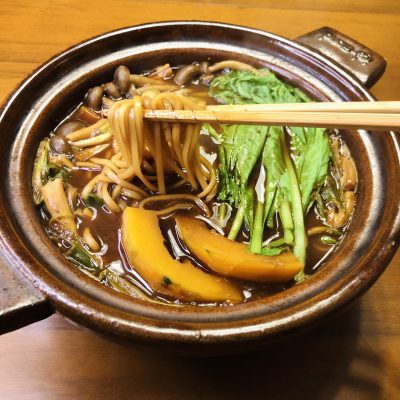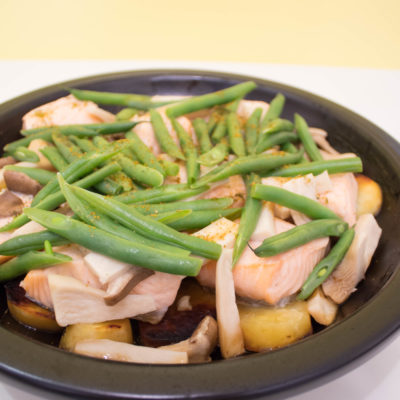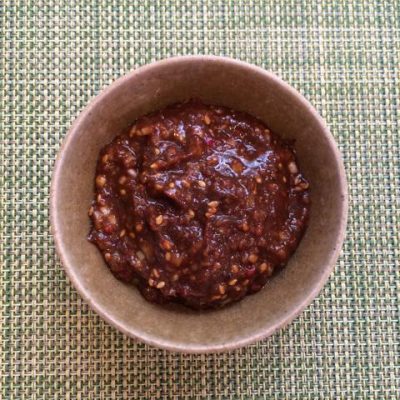Tag Archives: Shichimi togarashi
Shrimp Miso Udon
Perfect for a cold season, this is Shrimp and Udon, Simmered in Dark Miso Broth. There is something about the deep simmering sound and look of the donabe noodles in miso broth. I make this dish repeatedly in the cold season. It’s a brilliant single serving one pot donabe meal which has rich satisfying flavors and keeps my body warm so nicely. I like to coat the shrimp in katakuriko (potato starch – you can omit or substitute with corn starch), as it helps shrimp turn really nice plump texture and also lightly thickens the broth. Also, shrimp cooks fast and adds nice flavors to the broth, but you’re welcome to omit or replace with your choice of topping.
Halibut & Daikon Hot Pot
Here’s my healthy seafood hot pot, Halibut Mizore Nabe – Halibut (or your choice of fish) is quickly simmered with vegetables and finished with a generous amount of grated daikon on top. With the addition of the glass noodles, this dish makes a very satisfying one pot donabe meal.
Scallop Hot Pot in Miso Broth
I love scallops so much and usually get large-size sashimi grade scallops to eat in so many different ways. One of the regular dishes is this simple miso-based hot pot in a donabe. It’s made so quickly, and the scallops release so much flavors to make the broth taste so rich and wonderful. I like blending two kinds of miso (both available at TOIRO) for extra complexity.
Hatcho Miso Udon Hot Pot
This dish can be made so quickly and create a balanced one-pot meal. I love the deep flavor of hatcho miso which is a dark miso. The flavor is almost chocolaty. Once the udon noodles are par-cooked, all the ingredients are cooked in one donabe. I like vegetables and tofu in this dish, so this dish is completely vegan. But, if you like, you can also enjoy this dish with an addition of meat. Chicken or duck slices are particularly good.
Salmon and Daikon in Garlic Butter Miso Sauce
Garlic, miso, and butter…they make a brilliant combination of flavors. The main ingredients to cook in the sauce are salmon (or you can use your choice of high quality rich flavor fish) and daikon, and they are piled up with a few other ingredients and quickly simmered in the sauce. The dish has a nice rich flavor with refreshing accent with the yuzu juice. I used cilantro and daikon sprouts as a garnish for this recipe, but dill is also a nice alternative.
Steamed Green Beans and Potatoes in Sesame Peanut Butter Sauce
This simple steamed dish is always a big hit when I serve to my guests, and everybody loves watching the process of making it, too. When the potatoes and green beans are steamed in donabe, they tend to retain both the nutrients and texture, while the flavor becomes so rich and pure. To make the sauce, the sesame seeds are first roasted in horoku (sesame roster) until fragrant, then they are ground in suribachi and surikogi (Japanese mortar and pestle) and mixed with seasonings. The steamed vegetables are added directly to the sauce in the suribachi and tossed together. And, you can serve it right out of it at the table. Sesame and peanut butter add nice richness to the dish. For the sauce, I normally add leftover dashi (either kombu & shiitake mushroom dashi or kombu & bonito dashi) for extra subtle layer of flavors, but you can totally go with just water, if you don’t have dashi and it would still taste delicious.
Shiso Chicken Meatball & Grated Daikon Hot Pot
This dish is packed with nutrients, and so easy to make. It’s also a great dish to enjoy with guests. Chicken meatballs have the very nice subtle shiso flavor and they become fluffy after cooked. I like adding a generous amount of coarsely grated daikon (I highly recommend you use Onioroshi daikon grater for the nice crunchy texture for grating daikon). They give both texture and more flavor to the dish.
For seasoning, I use both white tamari and soy sauce for more complex flavor (and also to keep the broth from becoming too dark), but you can use just soy sauce if you like. You can also adjust the seasoning with extra sea salt at the end. But, please remember, this dish is served with Sansho Ponzu Sauce, so the seasoning should be minimum.
Make sure to save enough broth, so you can enjoy the shime (finishing course) of soba noodles!
Soup Udon with Steamed Vegetables
This vegan treat is so easy to make and very satisfying. You just prepare the dashi broth for the udon in the bottom bowl of the Mushi Nabe, set the steam grate on top to steam the vegetables first. Once the vegetables are ready, remove the grate and cook the udon in the broth. Because the vegetables are steamed, they tend to retain more nutrients and taste very pure. The ginger-scented broth stays also very clear and the flavor is so rich in kombu‘s umami. So, this is a win win dish. In this recipe, I used Bistro Mushi Nabe, but you can make this dish with any donabe which is equipped with a steam grate. Adjust the recipe amount according to your size of donabe.
Soba Noodle with Hot Mushroom Dipping Broth
I love making this dish especially when I am feeling a little weak and need something gentle for my stomach. Once you simmer mushrooms in a rich dashi-based broth, pour it into serving bowls and dip cold noodles in it to enjoy. The mushrooms adds the nice savory flavors to the broth. And, I love to use a generous amount of thinly-sliced ginger for both flavor and helping my body stay warm after having the dish. It’s so soothing and you can keep eating more and more. This dish is also nice to serve for a larger group. You can also change around the ingredients to cook in the broth for fun. For a vegan version, you can make with kombu dashi or vegetable dashi instead of kombu & bonito dashi.
Chicken Meatball Hot Pot in Miso Broth
This simple miso-flavored hot pot is always so popular among my family and friends. By adding grated ginger and egg, the chicken meatballs becomes so fluffy and flavorful. The other main ingredients are tofu and mushrooms, which complete the dish to full satisfaction. The suggested shime (finishing course) to cook in the saved broth is udon or ramen.
Shio-koji Salmon over Butter Sweet Potatoes
This dish is something I like to whip up especially on a busy day. While marinating the salmon in shio-koji, I I can prepare all the other ingredients, then just pile them up and let the donabe do all the work. I love the slightly caramelized sweet potato in the bottom, while the salmon is perfectly cooked medium-rare (or you can cook it longer if you like the salmon to be well-done).
Grilled Okra with Smoked Soy Sauce
This is a quick appetizer/side dish which requires little time for prepping. Toban cooks vegetables so effectively, allowing for them to become nicely charred. When the Smoked Soy Sauce is drizzled over the okra, it sizzles and brings an irresistible aroma. Finish with a generous mound of Shaved Katsuobushi, and sprinkle some Shichimi Togarashi. The katsuobushi will dance slowly on the okra and make a very appetizing presentation. I love making this dish with okra during the summer; asparagus is also great.
Shichimi-Flavored Cherry Tomato & Mint Pasta
When the cherry tomatoes are slowly heated with garlic and blistered in the oil in donabe, the flavor becomes even more bright and perfectly juicy. Once the tomatoes are blistered, all you need to do is just add the spaghetti, and toss with some mint. Finish with shaved Parmesan cheese and a generous amount of Shichimi Togarashi to enjoy. This simple dish is so rich and flavorful. I always have a hard time to stop heating it.
Cold Somen Noodle with Golden Sesame Dipping Sauce
During the hot summer season in LA or Tokyo, ice-cold somen noodle is often the only thing I feel like having, and I never get tired of it. Did you know donabe is a perfect vessel for serving cold dish, too? With the porous clay body, donabe can keep the cold food very cold for a extended period of time. Also, it simply looks pretty to serve anything out of donabe, too! For this dish, I introduce my golden sesame dipping sauce. It’s rich in flavor yet refreshing. As for the toppings/ condiments, you can make it as simple like just sliced scallion and Shichimi Togarashi, or you can create a wide array of different toppings when you serve this dish to your guests. In this recipe, I serve with smoked chicken tender, mixed herbs and Yuzu-Kosho.
Cold Ramen with Spicy Pork & Sesame Dipping Broth
Cold ramen noodles with simmering hot and spicy broth with toppings create a wonderful dish to enjoy in the summer or all year round. The dipping broth is especially rich as it’s seasoned with hatcho miso (very dark miso made of 100% soybeans) with tamari soy sauce. But, if you don’t have either, you can simply substitute with quality red miso and dark soy sauce respectively and it would still be very tasty. You can also serve the broth cold, and it will be so refreshing and perfect to enjoy on a hot day.
Steam-Fry Carrot in Oyster Mayo Sauce
This simple dish brings the wonderful natural sweet flavor of the carrot with the umami nuance from the oyster sauce and mayo. I also love the hint of nutty sesame aroma coming from the Golden Sesame Oil. I can make this dish so easily and it always feels like a treat. This dish is great either hot, right when it’s cooked, or at a room temperature. So, you can bring it to a picnic, too.
Chicken, Kabocha & Mochi Mugi Stew in Shio-Koji Broth
This hearty stew is so nourishing and tasty. The only seasoning is basically Liquid Shio-Koji, and this magical seasoning makes the chicken extra tender. With the addition of kabocha and Mochi Mugi barley, this dish tastes so complete and makes an ideal one pot meal. My body always feels so great after eating a big bowl of this stew. For this dish, I like making dashi (soup stock) with kombu and dried shiitake by soaking them in water for a few hours (to over night) in advance. They not only make the soup taste wonderful but also they can be sliced and added to cook in the stew to enjoy. But, you can also make this dish with chicken stock or vegetable stock and it will be delicious, too.
Lemon Butter Yellowtail and Daikon
This dish is my unique donabe version of popular Japanese dish, buri daikon (simmered yellowtail and daikon in soy based broth). Daikon is first sautéed in butter, then, once the yellowtail is added along with the lemon and mushrooms, they were steamed with sake and Ayu Fish Sauce. All made in one donabe, and this versatile Fukkura-san donabe effectively steam-fry the ingredients. The result is so aromatic, savory, and delicious. If yellowtail is not available, this dish can be made with other rich-flavor fish such as cod or sea bass. Ayu fish sauce gives the elegantly rich umami flavor, but it can be substituted with regular soy sauce, too.
Somen Noodle and Cherry Blossoms Hot Pot
I always get so excited when the spring season comes and make a lot of cherry blossom-theme dishes. This is one of them and I add salt-preserved sakura (cherry blossom) flowers to the broth, and I even use the pink sakura-flavored somennoodles made from flour and sakura from Japan. The aroma of sakura in this dish is just so beautiful. But, don’t worry if you don’t have any of them! You can totally make the delicious somen hot pot without the sakura flavors, and this dish can be enjoyed all year round. You can also change the other ingredients to cook with the noodles by using different kinds of mushrooms or tofu, if you like. It’s so gentle on the stomach and always comforting.
Salt Butter Chanko Hot Pot
Japanese sumo wrestlers cook and eat chanko nabe at their stable every day. That’s the source of their strength. While chanko nabe refers to any types of hot pot eaten by sumo wrestlers, the most typical style is chicken as a main protein and cooked in chicken broth. It’s because chicken stands on two legs like human beings, so it is considered to bring good luck (in sumo, you lose if your hands touch the ground). Chanko nabe typically makes a very nutritious and balanced meal, as you cook a wide variety of healthy ingredients in one pot. The sumo wrestlers are big, because they eat so much of it every meal! In my version, I cook chicken meatballs and vegetables in simple salt-flavored chicken broth, and add butter cubes right before serving. The aroma is so irresistible and the flavor is superb. As a shime (finishing course), I suggest ramen noodles to cook in the remaining broth.
Taro and Konnyaku Stew
Sato-imo (Japanese taro) is one of my favorite ingredients in the fall to winter seasons. When it’s simmered in broth, it becomes creamy inside and flavor becomes rich. This goes well with konnyaku (yam jelly) and makes such a hearty healthy treat. I used ball shape konnyaku in this recipe, but you can just get a block of konnyaku and tear into bite-size pieces by hand, so they will absorb the flavors from the broth well. This dish tastes delicious right when it’s ready, but I like it even more after a few hours of resting. If you let it rest for a few hours or longer. You can reheat it or serve at room temperature.
Korean-style Spicy Miso Condiment
This Korean-inspird spicy miso sauce is great with grilled or steamed meat, seafood, or even as a dipping for vegetable crudités (fresh vegetable sticks). I love serving this especially with grilled kalbi (beef short ribs) or steamed pork shoulder to make lettuce wraps. Both the hatcho miso and Okinawa black sugar make the flavor so deep, but you can also make with regular miso and brown sugar, if you like.
Japanese Beef & Potato Stew
This hearty beef and potato stew is such a popular Japanese home dish among people from little kids to elders. While there are countless variations, for my nikujaga, I like to caramelize the onion before adding other ingredients. The onion gives nice rich layer of umami flavor to the dish. Miso-shiru Nabe always makes the perfect caramelized onion without having to constantly sauté it. I also add a lot of thinly sliced gingers for the accent.






























